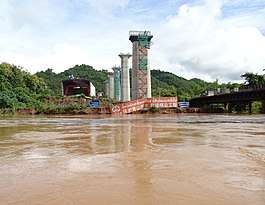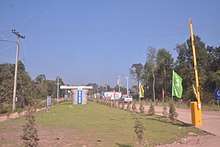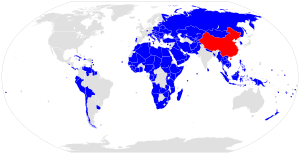Vientiane–Boten railway
The Vientiane–Boten railway (often referred to as the China–Laos railway) is a 414 kilometres (257 mi) 1,435 mm (4 ft 8 1⁄2 in) standard gauge railway under construction in Laos, between the capital Vientiane and the small town of Boten on the border with China.
| China–Laos railway | |
|---|---|
 Bridge construction near Luang Prabang. | |
| Overview | |
| Status | Under construction |
| Locale | Laos |
| Operation | |
| Commenced | December 2016[1] |
| Planned opening | December 2021[2] |
| Technical | |
| Line length | 414[3] km (257 mi) |
| Number of tracks | 1 |
| Track gauge | 1,435 mm (4 ft 8 1⁄2 in) standard gauge |
| Electrification | Overhead line |
| Operating speed | 160 km/h (passengers) 120 km/h (cargo)[1] |
Vientiane–Boten railway | ||||||||||||||||||||||||||||||||||||||||||||||||||||||||||||||||||||||||||||||||||||||||||||||||||||||||||||||||||||||||||||||||||||||||||||||||||||||||||||||||||||||||||||||||||||||
|---|---|---|---|---|---|---|---|---|---|---|---|---|---|---|---|---|---|---|---|---|---|---|---|---|---|---|---|---|---|---|---|---|---|---|---|---|---|---|---|---|---|---|---|---|---|---|---|---|---|---|---|---|---|---|---|---|---|---|---|---|---|---|---|---|---|---|---|---|---|---|---|---|---|---|---|---|---|---|---|---|---|---|---|---|---|---|---|---|---|---|---|---|---|---|---|---|---|---|---|---|---|---|---|---|---|---|---|---|---|---|---|---|---|---|---|---|---|---|---|---|---|---|---|---|---|---|---|---|---|---|---|---|---|---|---|---|---|---|---|---|---|---|---|---|---|---|---|---|---|---|---|---|---|---|---|---|---|---|---|---|---|---|---|---|---|---|---|---|---|---|---|---|---|---|---|---|---|---|---|---|---|---|
| ||||||||||||||||||||||||||||||||||||||||||||||||||||||||||||||||||||||||||||||||||||||||||||||||||||||||||||||||||||||||||||||||||||||||||||||||||||||||||||||||||||||||||||||||||||||
In the north the line will be connected to the Chinese rail system in Mohan, through the Yuxi–Mohan railway. In the south it meets the existing metre-gauge railway in Thanaleng, linking it via Nhong Khai in Thailand to Bangkok. A high-speed, standard gauge extension to Bangkok is also under construction. When finished, the Vientiane–Boten railway will form an important part of the Kunming–Singapore railway.
China aims to build a 5,500-km trans-Asia railway, which begins in Yunnan's provincial capital Kunming and travels through Laos, Myanmar, Thailand, Vietnam, Cambodia and Malaysia, before ending in Singapore, according to Ding He, a deputy project manager for the China–Laos railway project.[4]
Background
Laos is the only landlocked country in Southeast Asia, which hinders trade of goods. A railway link through Laos would greatly reduce cargo transit times and transportation costs between Laos and China. The railway would also be a link in the Kunming–Singapore railway network, as well as a program within the One Belt One Road Initiative.
History
The first talks about the railway linking Laos and China were in 2001, Laotian and Chinese politicians both confirmed the plans in 2009. After the corruption scandal of China's minister of railways Liu Zhijun, the start of construction was delayed until early 2016.[5]
Construction began at Luang Prabang on December 25, 2016.[6] At the end of 2017, the construction phase was 20% completed,[7] and in September 2019 progress was reported as 80% completed.[8] Unexploded bombs that have been dropped during the Vietnam War will also be removed along the route.[9]
Financing
The cost of the project is estimated at 5.95 billion US dollars, to be financed 12% by Laos directly, 28% by China, with the remaining 60% being financed by loans.[5]
Infrastructure

Forty-seven percent of the railway will be in 75 tunnels and 15% will pass over viaducts spread over 167 bridges.[5] There are 32 planned stations along the route.[6] The final station would be Thanaleng station, not Vientiane Station. Xay Village in Xaythany District is to be the site of Vientiane Station, the largest station on the railway. The station will consist of four platforms with seven track lines and two additional platforms with three lines reserved. It is expected to connect with other railway lines planned for Laos. The station will accommodate up to 2,500 passengers with a total area of 14,543 square meters.[10]
The railway is to be built to China's GB Grade 1 standard (suitable for 160 km/h passenger and 120 km/h freight trains).
A new bridge will be constructed by 2023 from Thanaleng to Nong khai to connect the high speed rail network into Thailand.
As of June 2020, Chinese state media reported that the US$6 billion project was 90% done. Work crews started laying track in Laos in March 2020, five years after breaking ground. With most of the many dozen tunnels and bridges completed, service is set to start by 2022.[11]
See also
- Rail transport in Laos
- Vientiane–Vang Vieng Expressway
References
- "Laos-China railway brings changes to Laos". China Daily. 7 August 2017.
- "China's rail network opens up transport links in Laos". The Star. 20 Jan 2020.
- "China–Laos railway project set to be complete by late 2021". People's Daily. 20 November 2017.
- "China–Laos railway achieves tech breakthrough". China Daily. 30 April 2019.
- "Land-locked Laos on track for controversial China rail link". Nikkei Asian Review. 24 June 2017.
- "Everything You Need to Know About the Laos–China Railway". The Laotian Times. 20 February 2017. Retrieved 2018-12-20.
- "Laos–China railway '20.3 per cent complete', compensation still unpaid". The Nation. 7 February 2018. Archived from the original on 2019-06-12.
- "Nearly 80 pct of China–Laos railway construction completed". Xinhua News Agency. 22 September 2019. Retrieved 2020-01-31.
- "Unexploded ordnance to be cleaned along Laos–China railway". China Internet Information Center.
- Phonevilay, Latsamy (4 July 2020). "Construction of Vientiane Station Commences on Laos–China Railway". The Laotian Times. Retrieved 6 July 2020.
- Peter, Zsombor (28 June 2020). "China Plows Ahead with High-Speed Rail Line for Southeast Asia". VOA News. Retrieved 29 June 2020.
External links
- Laos–China Railway Co., Ltd. – a joint venture between Laos and China to build and operate the railway.
- Vientiane–Boten railway on OpenStreetMap
- Vientiane–Boten railway on Google Maps
- Full construction details superimposed on a satellite map by Design for Conservation
